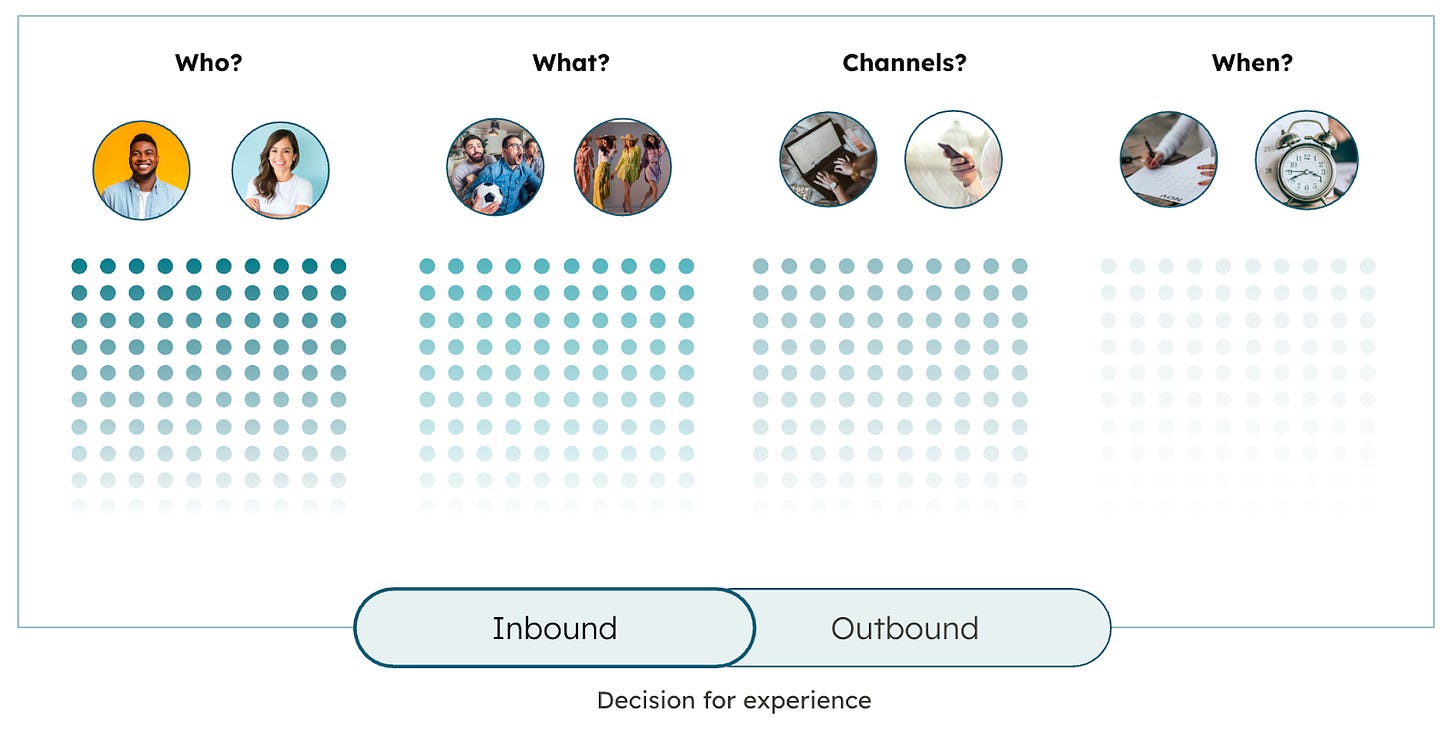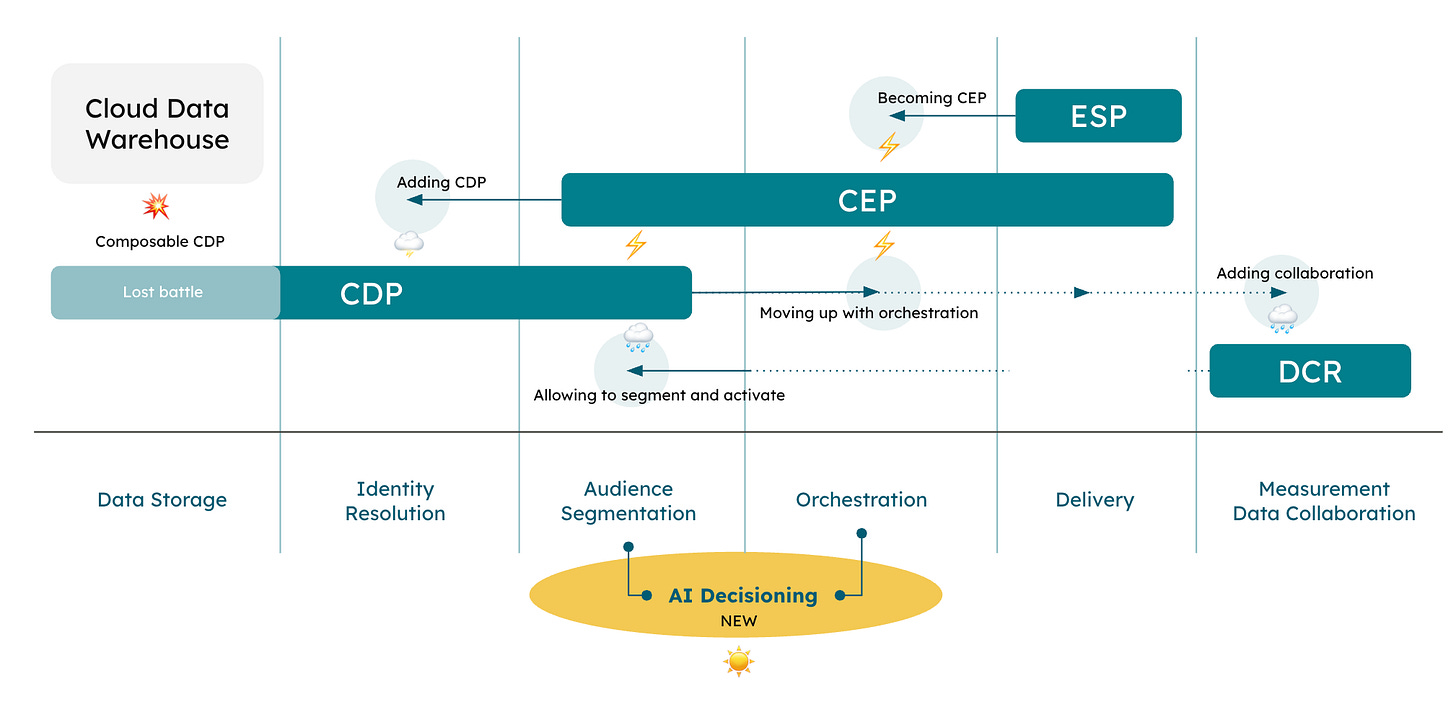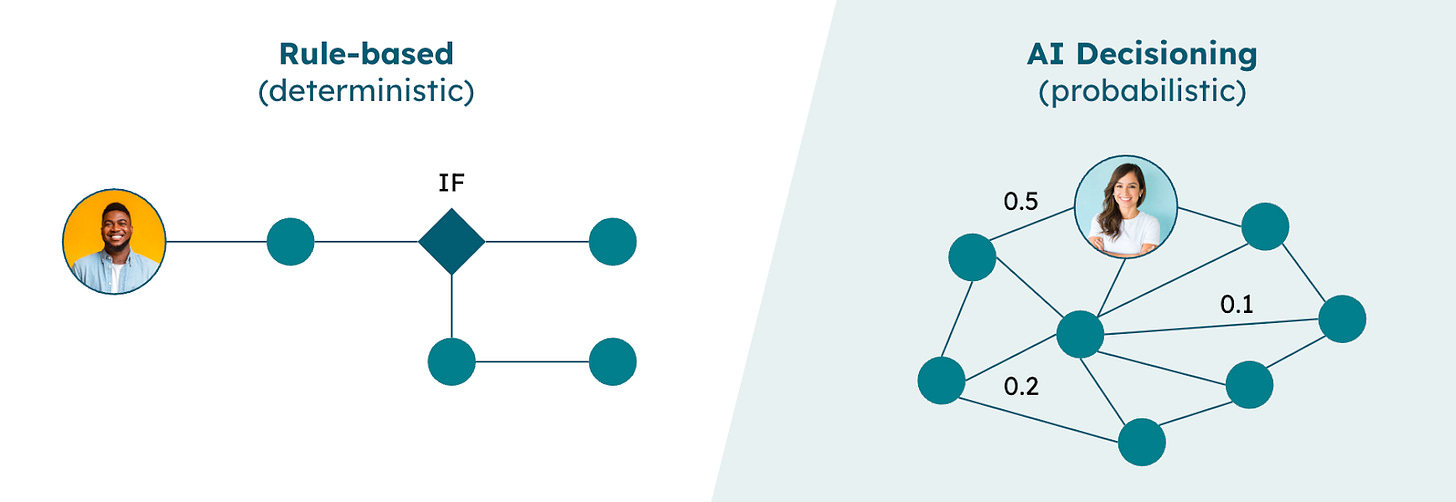During my time working in martech, one persistent gap has stood out to me: decisioning.
Pega has long been recognized for real-time decisioning. But unless you're a large enterprise with significant resources and budget, its solution is notoriously difficult to implement and maintain. And alternative solutions have been hard to find.
The challenge isn’t a lack of demand—it’s that decisioning is a hard problem to solve.
Meanwhile, marketers face an ever-growing number of decisions every day.
But here’s the good news: AI-powered decisioning solutions are finally on the rise—and they’re coming stronger than ever.
What is AI Decisioning?
The term "AI decisioning" might feel new, but the underlying concept isn’t. For years, we've talked about things like "next best action" or "next best offer."
Think of a customer browsing credit card options on a financial services site. They move on to another section—should we promote one of those cards again? If they abandon the site altogether, should we follow up via email or retarget them with ads?
Those are all decisions. But marketers face more questions to answer:
Who should I target?
With what content?
On which channel?
At what time?
And then there’s the timing of the decision:
Do we need an immediate response—something to influence the next page view or interaction (inbound)? Or are we planning an outbound message, where there’s more time to think, analyze, and decide?
How Decisioning Is Done Today
In practice, I see two dominant approaches:
1. Audience-first
Marketers define a customer journey or workflow. Who qualifies for what message, when, and under which conditions—all visualized and implemented using journey orchestration tools.
2. Action-, Offer-, or Product-first
This flips the model: you start with the action, offer, or product and define eligibility rules. For example, a credit card might only apply to customers within a certain income bracket. You may also assign priorities, allowing the system to select the single “best” product among several eligible ones in a given context.
Both methods rely on pre-defined logic. That means human-built rules—often many of them.
The Rule-Based Dilemma
Here’s the issue: rule-based systems give marketers control—but that control comes at a cost.
During my consulting years, I helped teams set up massive rule libraries across product catalogs, segments, and use cases. Deploying those rules wasn’t the challenging part. Testing, maintaining, and scaling them? That’s where things got messy.
Expiration dates, overlapping eligibility, edge cases, business exceptions... it becomes unmanageable fast.
The result? Organizations simplify. They strip out rules. They reduce complexity. But that often comes at the expense of personalization, relevance, and ultimately, effectiveness.
That’s inefficient marketing—and a missed revenue opportunity.
Consumer Expectations are Still Rising
Consumer expectations are still rising. The number of decisions and logic that marketers have to anticipate isn’t slowing down—it’s accelerating. And companies are struggling to keep up.
Here’s a small but telling example: last week, I got an email from eBay asking me to rate a package that USPS hadn’t even delivered yet. A well-intended automation, sure—but it completely missed the mark. The decision to send that feedback request clearly didn’t consider real-time delivery status. USPS caused the delay, but eBay didn’t account for it.
That’s the kind of small misstep that erodes trust in a brand.
Systems with rigid workflows and static rules have limitations impossible to overcome with people.
Enter: AI Decisioning, the Next Battleground
The industry is finally responding.
In August 2024, Hightouch released its AI Decisioning product. Coincidentally, in March 2025, Braze acquired OfferFit. In parallel, Adobe has had an Offer Decisioning solution for some time within its Experience Cloud suite—even if it remained in the shadows.
So, when I wrote about CDPs increasingly overlapping with Customer Engagement Platforms (CEPs) through journey orchestration, I meant it. But decisioning may be the real next battleground in martech.
We’re moving from rule-based (deterministic) decisioning to autonomous decisioning powered by AI (probabilistic).
I wouldn’t be surprised if more martech vendors—CDPs and CEPs alike—launch decisioning solutions through the end of 2025 and into 2026.
A Word of Caution: Data Still Makes the Difference
Will “AI decisioning” become the next hot martech category? Maybe. But if the CDP space taught us anything, it’s this: multiple approaches will emerge, and buyers will face a complex landscape.
Some solutions will embed decisioning into orchestration tools. Others will offer it as a standalone engine. Some will lean on historical data; others will prioritize real-time signals. And yes—every demo will look great.
But you know the drill: great decisioning starts with great data.
If your data is incomplete, fragmented, or out of sync, AI won’t magically fix your decisions. It’ll just make the wrong ones faster and more confidently. Even with a best-in-class model.
We’ve seen this with generative AI and LLMs: general-purpose models alone don’t solve enterprise challenges. The magic happens when they’re connected to enterprise data. The same principle applies here—AI decisioning is only as strong as the data foundation it’s built on.
That’s why I believe the most impactful solutions won’t live in isolated tools or mini-databases. They’ll be built directly on top of enterprise-grade data platforms like Snowflake, Databricks, AWS, Google Cloud, or Microsoft Azure. That’s where the full customer context lives.
It’s the same shift we saw with composable CDPs. Rather than copying data into packaged software, brands are tapping into their enterprise data platforms—and building marketing capabilities on top of that foundation.
AI decisioning will follow the same path.
🔑 So keep in mind, AI decisioning is coming, but if the model makes the move, your data decides the outcome.




